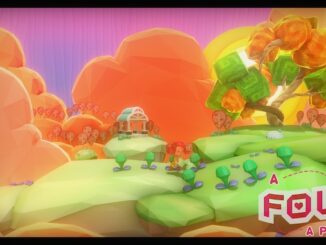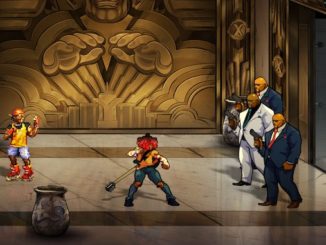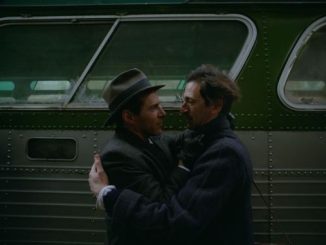Our review of The Legend of Zelda: Tears of the Kingdom, developed by Nintendo. Available now for Nintendo Switch.
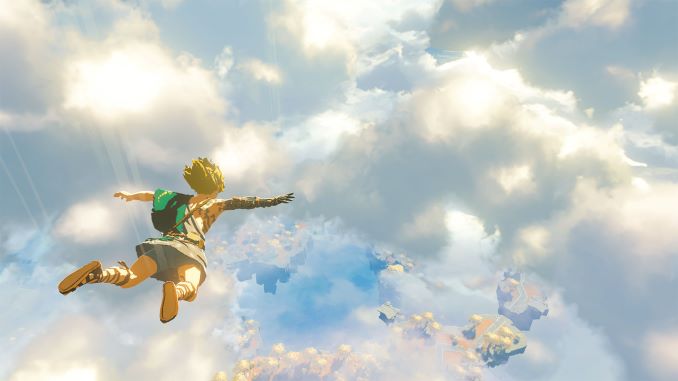
WHAT IS IT?
Oh, y’know, only the most talked-about video game since The Legend of Zelda: Breath of the Wild.
IS IT GOOD?
It is a very good Zelda game and if you can spare the time you’ll likely finish it by early 2025.
WHO SHOULD PLAY IT?
I’m happily just going to go with “everyone” this time.
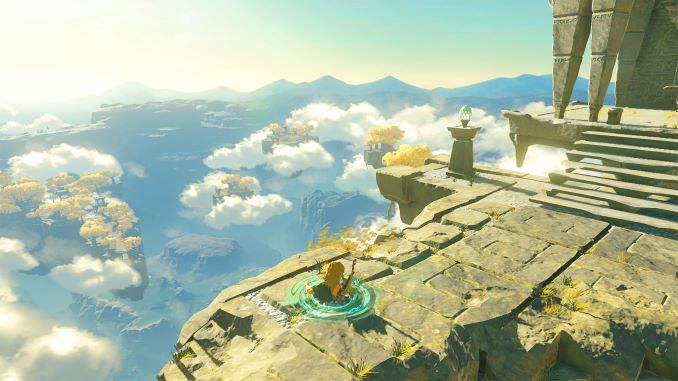
DEEP BREATH
I find myself in the unique position of having never played Breath of the Wild.
It’s not that I’m no Zelda fan – I consider Ocarina of Time one of the truly great games – but, for various reasons, I missed out on Breath‘s original release and then, as these things happen, time slipped by.
It’s both a blessing and a curse that I come to its sequel, Tears of the Kingdom, relatively fresh. Genuinely not knowing what to expect, I’ve been able to evaluate Tears on its own terms, without the shadow of its older sister hanging over its head. And yet, I’m keenly aware that I’m missing certain details – the return of characters, the way abilities and even the landscape have evolved since the previous game – which would flesh out the experience, and which are sure to bring delight to returning players.
Keeping that in mind, I’ve found Tears to be enjoyable, compelling, and beautiful… but also occasionally frustrating in ways that I was not expecting.
Tears of the Kingdom might be the game of 2023, but I have yet to be convinced that it is the Zelda game. (That honour goes to Ōkami, of course :P)
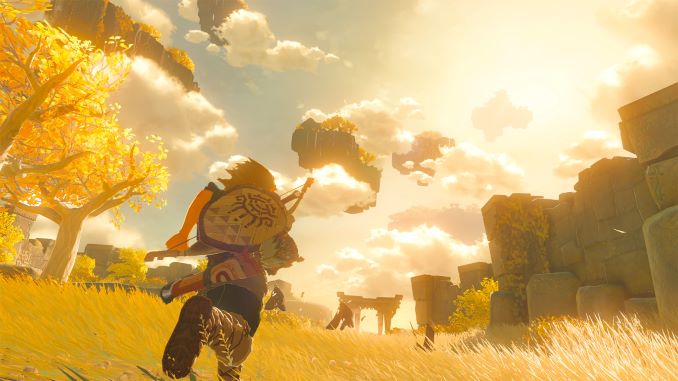
WHERE IT STARTED
There’s always a lighthouse, there’s always a man, there’s always a city.
Oh wait, sorry, that’s BioShock.
Let’s try that again: there’s always a temple, there’s always a man, there’s always a kingdom.
For decades, the Zelda series has adopted a storytelling approach which might best be described as “variations on a common theme”: rather than a string of straight sequels, each successive Zelda game has told a new, albeit familiar story, set in a new, albeit familiar world, untethered to what came before.
And so: the “Dark Link” of A Link to the Past is not the Dark Link of Ocarina of Time. The Hyrule Castle of Wind Waker is not the Hyrule Castle of Twilight Princess. Most importantly, the characters – Link, Princess Zelda, Ganon – may look and sound like the Links and Zeldas and Ganondorfs of before, but each time they are slightly different, inhabiting their own particular universe with its own unique history. There are exceptions – Majora’s Mask is a sequel to (the best Zelda game) Ocarina of Time – and a few games have alluded to a sort of shared, multiversal timeline, not unlike BioShock or the Marvel movies. Still, a direct sequel is a rarity.
The existence of Tears of the Kingdom is, in other words, a singular moment in gaming history. The sequel to what is widely considered one of the greatest video games of all time, it returns to the Hyrule of Breath of the Wild, with the Link and Zelda, memories intact from their last adventure, in tow. It also brings with it the same refreshing approach to Zelda for which Breath was so celebrated, an approach which emphasizes exploration, experimentation, and, for lack of a better word, remix.
In Tears as in Breath, players are encouraged to mix and match everything, from food, to weapons, to objects, to environmental features, finding new and exciting ways to explore its lovingly realized world. Chop down some trees, attach them to a nearby canvas, and mount a high-powered fan to the back: you’ve just built yourself a makeshift sailboat. Defeat a goblin, claim its sword, graft a boulder to the end of it, and you’ve got a giant war hammer, capable of smashing through enemies and hidden entrances alike. And those are already things you’ll do in the first half hour of the game.
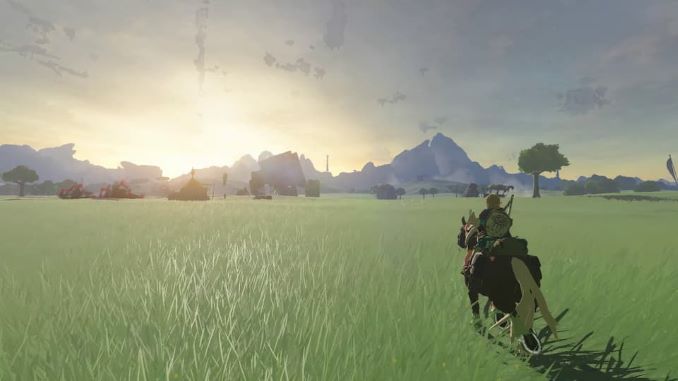
RECALL
Seven years ago, Hyrule fell to the dark forces of “Calamity Ganon”, a giant, malformed monster variation on classic Zelda villain Ganondorf. Only thanks to the combined forces of the Kingdom of Hyrule – the Gerudo of the desert, the avian Rito, the rocky Gorons, the aquatic Zora, not to mention Princess Zelda and elf-like protagonist Link – was total destruction narrowly averted, the evil of Ganon banished from the world.
Or so we thought.
As all good sequels go, it turns out our heroes only earned a temporary reprieve. When Tears of the Kingdom opens, a period of relative peace is now under threat from a mysterious “gloom” – a spooky mist which brings illness to anyone exposed to it – seeping out from the unexplored depths of Hyrule. When Zelda and Link descend into the caverns below Hyrule Castle, they uncover an ancient evil – yep, one of those! – that threatens to undo all the hard work of rebuilding since the “Calamity” of the last game. All of which is, of course, mere setup to yet another epic adventure in which Link must travel to the ends of the earth (well, kingdom), solving mysteries, building alliances, and slowly cultivating the skills, techniques, and abilities required to take on Tears‘s toughest challenges.
Gameplay in Tears is, as one might expect, rock-solid. Played from a third-person perspective, Link is quick and responsive in combat, nimble in traversing the varied terrain (which ranges from islands in the sky to vast underground caverns below), and armed with a surfeit of special abilities, only some of which are repeats from Breath. In certain respects, Tears reminds me of, of all things, Super Mario 64, in that it’s just so much fun to move around in, to the point you can spend hours goofing off, gleefully abandoning the world-saving quest you’ve taken on.
It helps that the Hyrule of Tears is easily the best-realized of any Zelda game to date, elegantly absorbing the influences of countless Zeldas past, from the sky-high islands of Skyward Sword to the cel-shaded aesthetic of Wind Waker. Whether it’s the aquatic environments of Zora’s Domain (always a favourite) or the blistering heat of the Gerudo Desert, everything in Tears is beautifully designed, overflowing with secrets, and a joy to explore. And, as in the best open-world games, if you can see something, no matter how distant, you can get to it, though it may take time until you have the means to get there. (Don’t make the same mistake I did, trying to ascend a mountain without proper clothes or “warming” food.)
On that note, I can confirm that Breath‘s paraglider makes a return appearance, quickly becoming a highly valued piece of equipment which makes it fun to get from Point A to Point B, something which was not necessarily true in the older Zelda titles. As for Link’s new abilities, of which I am hesitant to spoil too much, there are definitely some interesting ones, as well as some that have rather limited use.
That said, certain abilities probably could have used refinement. To take one example: the ability to attach nearly anything to your weapon is amazing, as is the ability to attach environmental objects together, constructing something like that sailboat I mentioned earlier. What’s confusing, however, is why this basic power – attach X to Y – is separated into two different abilities, requiring entirely different button inputs, even down to pressing the “A” button in one case, but “Y” in the other.
Far more cumbersome, however, are the cooking and elixir-brewing systems, which require that you navigate a half-dozen menus and hundreds of item descriptions to figure out, say, which fruit goes with which seasoning, or which monster fang goes with which mineral. The right combination will buff your strength or make you heat-resistant, but I wish I didn’t have to pause quite so often to browse, organize, and figure out what’s needed at a particular moment. I don’t know that there’s a solution to this – any open-world game with a crafting system is bound to devolve into a confusing sea of menus – but it’s striking that in the six years since Breath Nintendo hasn’t come up with anything better.
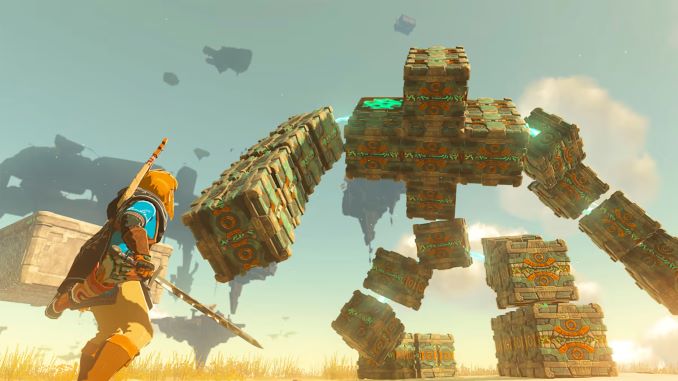
ASCEND
One of the first things I did in Tears of the Kingdom was build a makeshift chairlift — a board and two metal hooks hacked together, then affixed to a long metal rail extending across a chasm. Once I’d glided across to the other side, I tore the chairlift apart, repurposing its baseboard as a ramp to help me reach some nearby treasure. Tears of the Kingdom did not tell me to do these things, but it gave me the tools to do so, and waited for me to figure it out.
At its best, Tears of the Kingdom is full of moments like these: moments where you see something you want (or which piques your interest), and where you need to figure out how to get there. Building a bespoke vehicle or makeshift ladder is quick and easy to do, and you’re usually rewarded for it. Similarly, experimenting with combat techniques – firing a flaming arrow at a walking tree, adding a projectile-vomiting sculpt to the face of your shield – can get you past enemies you might otherwise be destroyed by — though experimentation can also get you killed, fast.
And I haven’t even mentioned Tears‘s greatest addition: the wealth of ancient technology left behind by a forgotten race (no spoilers!), here for you to discover, test out, and see what you can make of it. There’s the simple stuff, like the aforementioned fan, which can be used as a propeller or as a way to snuff out fires. Then there’s the more complex tech, like the “magnet” which lets you swing an object from horizontal to vertical by hitting it with a melee weapon. Figuring out that technology, which can be used to build something flat, then erect it with the tap of a button, is initially confusing, but dedicated players will eventually find all sorts of nifty uses for it.
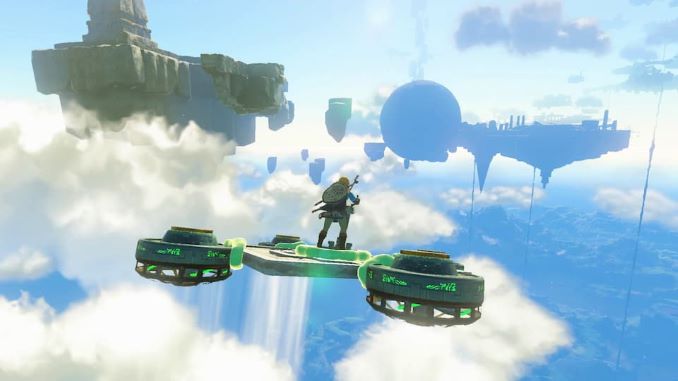
THE OCARINA FLOATS SKYWARD IN THE WAKE OF THE TWILIGHT WIND
Tears‘s greatest strength is also its greatest weakness: in embracing such a free-flowing “choose-your-own” approach to its open world, it is, sadly, far too easy in Tears to get lost, overwhelmed, or otherwise hit a progression wall.
Much of the blame lies in the game’s failure to telegraph what’s required of you in a particular area or particular mission. This makes it impossible to tell whether you’re struggling because you’re supposed to, or because you’re trying to take on something you’re not yet equipped for. You may spend hours – literally, hours – exploring a given area, only to realize later that you could have saved all that trouble if you’d just waited until you unlocked a specific ability. (This problem also reared its head in Elden Ring, though I generally think FromSoftware handled it better there.)
Younger players in particular may struggle with the general everything-everywhere-all-at-once vibe to Tears of the Kingdom. Do I investigate this mysterious object over here, or do I try to reach that shrine over there? Do I help this villager with their secondary, yet tantalizing, side quest, or do I stick to the main mission, which I’m not even sure I’m prepared for? Do I go north or south? Up or down? While I don’t exactly miss the days of Navi shouting “hey listen!” at me every five minutes, I do sometimes wish Tears had a bit more focus, was more willing to nudge players in the right direction – or at least, the direction where you’re not going to be punished for having the wrong equipment.
Other things simply aren’t explained, or explained so poorly that Nintendo must be counting on players remembering details from the last game. Why did it take a dozen hours before the game finally bothered to offer me a horse? Why are rupees – Zelda’s in-game currency – so hard to come by for so long? Why are there so many goddamn korok seeds to collect? Not one of these problems is fatal – indeed, most are eventually addressed in a satisfying way – but there are definitely large chunks of Tears where some part of your brain will be fretting, am I doing this right? Did I miss something?
In the end, though, none of that really matters. When I wrote earlier that I’d never experienced Breath of the Wild, that wasn’t quite true: in fact, I have fond memories of watching a friend wander joyfully through the Hyrule landscape, distracted by some juicy-looking fruit over here or a goofy-looking “Moblin” over there. Even just watching it in action, I could tell that Breath was something special, something which rewarded the curious player and which was never anything less than entertaining.
And so it goes with Tears of the Kingdom. So what if I spend hours needlessly clambering up the face of a cliff, when there’s a fantastic view at the top of it? So what if I die a thousand times to overpowered enemies, when the game later lets me go back and trounce them with my augmented powers? So what if I misunderstand a quest clue, sending me off on a wild goose chase, when that chase leads me to cool areas I might not have seen otherwise?
Tears of the Kingdom is, truly, an epic – it will take upwards of 100 hours to see everything it has to offer – and a worthy successor to the Zelda name, including the many, many, many influences it wears on its tunic sleeve.
Now if you’ll excuse me, I’m back to harvesting Voltfruit. Or exploring shrines. Or, uh, someone mentioned a rare treasure over that way. Or how about that enigmatic clue about some magical armour? Wait, what was I doing again?
***
Final score: 9/10 Gerudo Valley flamenco remixes.
Visit the official website for The Legend of Zelda: Tears of the Kingdom here.

